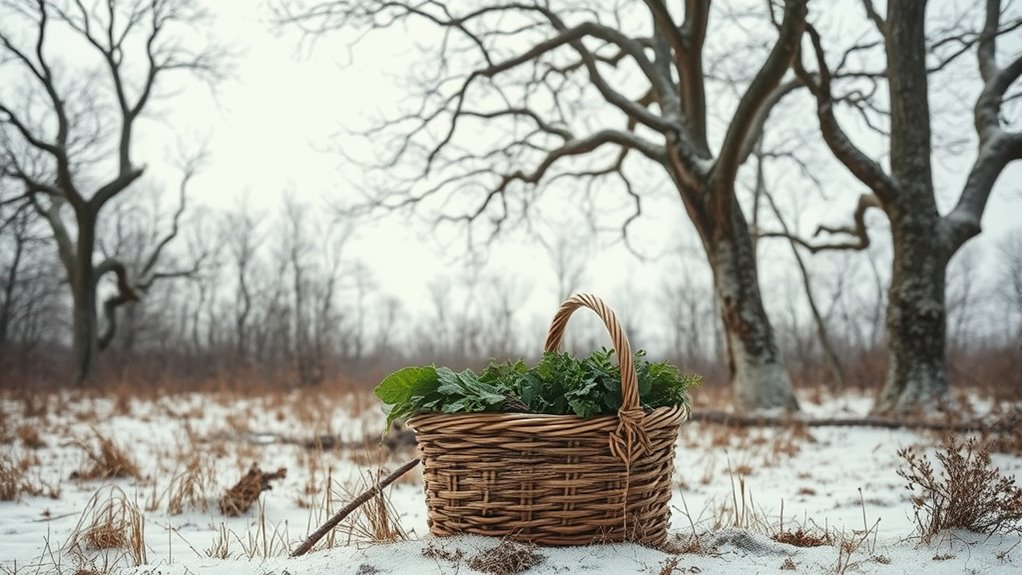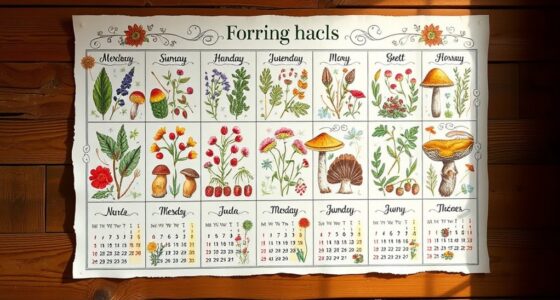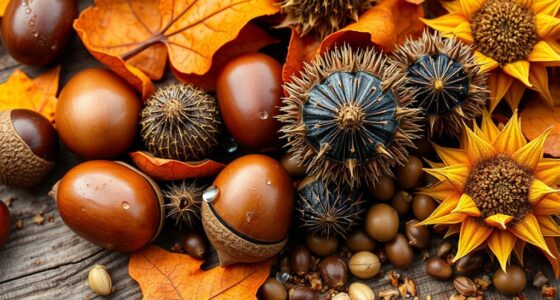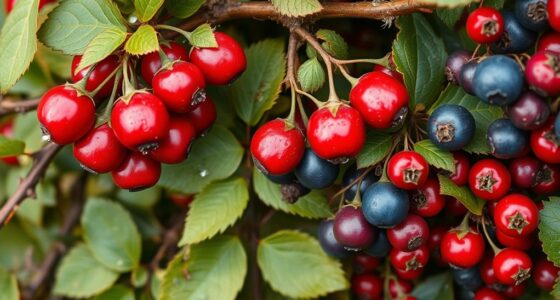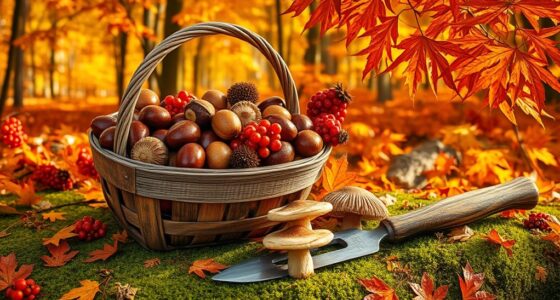In January, focus on identifying hardy plants like wintercress, chickweed, and roots such as burdock or wild carrots, which can often be dug up during this season. Keep an eye out for evergreen foliage and seed heads that stand out against the dormant landscape. Use tools like scissors and a small trowel to harvest sustainably, and always double-check your plant IDs for safety. Staying mindful of conditions and plant health will boost your success—exploring more can deepen your skills in this seasonal pursuit.
Key Takeaways
- Identify winter greens like wintercress and chickweed in protected patches using reliable field guides.
- Use tools such as scissors, a basket, and a trowel for safe, efficient harvesting.
- Observe evergreen foliage and seed heads as indicators of edible plants amidst dormant landscapes.
- Prioritize sustainable harvesting by taking only what is needed and avoiding overharvesting.
- Always confirm plant identities to prevent poisoning and choose safe, uncontaminated foraging sites.
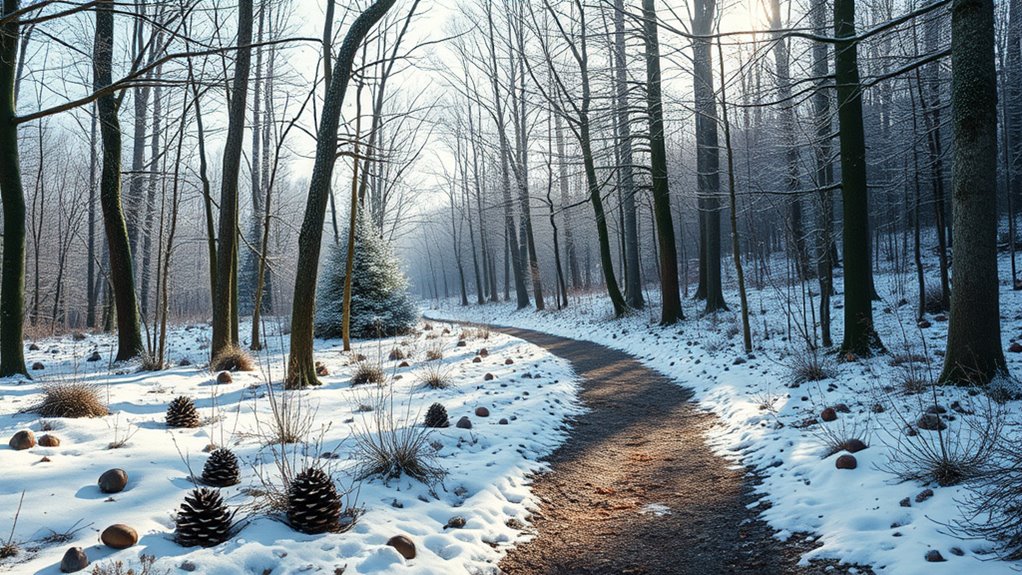
Starting on a foraging trip can be rewarding, but it requires careful preparation to guarantee safety and success. In January, when landscapes are dormant, the thrill of discovering wild edible plants lies in knowing where to look and what to expect. This is your chance to connect deeply with nature’s quiet resilience, to gather nourishment from the subtle signs of life still present beneath the bare branches and frosty ground. To do this effectively, you need to understand seasonal foraging tips that align with winter’s rhythms, ensuring you’re harvesting responsibly and safely.
First, focus on identifying wild edible plants that thrive during the winter months. Many plants enter dormancy, but some remain accessible and nutritious. For example, certain wild greens like wintercress and chickweed can often be found in protected patches. Roots such as burdock and wild carrots are also worth digging up, but always confirm their identity to avoid confusion with toxic look-alikes. Remember, proper identification is your top priority—if you’re unsure, don’t take a risk. Use a reliable field guide or consult experienced foragers to sharpen your recognition skills.
Seasonal foraging tips emphasize the importance of timing and observation. During January, the landscape’s starkness makes it easier to spot plants that are still standing or pushing through the snow. Look for clues like evergreen foliage and persistent seed heads, which can be indicators of edible options. Also, pay attention to changes in the land—frozen ground can sometimes reveal hidden patches of wild herbs or fungi, just be cautious with mushrooms, as many are toxic in winter. Always harvest sustainably; take only what you need and leave enough for the plants to continue thriving and for wildlife to feed.
In addition, your preparation should include the right tools—sharp scissors, a basket, and maybe a small trowel—so you can harvest efficiently without damaging the plants. Dress warmly, as winter foraging demands patience and endurance, and be mindful of weather conditions that could make the terrain slippery or treacherous. Being aware of plant growth cycles can help you determine the best times for sustainable harvesting. Foraging in winter is about patience and keen observation, and it’s a way to feel liberated from reliance on stores, reconnecting with nature’s cycles.
Frequently Asked Questions
Are Winter Foraging Tips Suitable for Beginners?
Yes, winter foraging tips are great for beginners. You can learn to recognize seasonal plant cues and understand winter plant adaptations, which make identifying safe, edible plants easier during this season. Embrace the liberation that comes with exploring dormant landscapes and trusting your instincts. With patience and curiosity, you’ll develop skills that turn winter into an adventure, revealing nature’s hidden gifts in the quiet, cold months.
How Can I Identify Edible Plants in Winter?
Remember, “a little knowledge is a dangerous thing.” To identify edible plants in winter, look for plants with distinctive characteristics like bark, buds, or remaining berries. Use your winter foraging tools—a good field guide, a sharp knife, and a keen eye. Focus on plants that stand out against the snow, and trust your instincts. You’re free to explore, just stay informed, and always verify before you indulge.
What Safety Precautions Should I Take When Foraging?
When foraging, always stay alert to avoid poisonous plants. Use your foraging gear, like gloves and a knife, to handle plants safely and prevent accidental poisoning. Confirm plant identifications with reliable guides before consuming anything. Trust your instincts, but don’t take risks—if you’re unsure about a plant’s safety, leave it untouched. Prioritize safety to enjoy the freedom of foraging without danger or harm.
Can I Forage in Urban Winter Environments Safely?
Yes, you can forage safely in urban winter environments if you stay alert and practice winter plant identification. Focus on hardy, resilient plants like certain herbs or tree bark, and avoid areas with heavy pollution or chemicals. Urban foraging offers liberation from traditional food sources, but always double-check plant identification, avoid contaminated sites, and harvest responsibly. Embrace the freedom of connecting with nature, even in winter’s quiet landscape.
Are There Legal Restrictions on Winter Foraging?
Yes, there are legal restrictions on winter foraging. You need to check seasonal plant laws in your area, as they vary by location. Some places require foraging permits, especially if you’re harvesting on public land. Always stay informed and respect local regulations to avoid fines or confiscation. Your foraging freedom depends on understanding and adhering to these rules, ensuring you can enjoy nature’s bounty responsibly and legally.
Conclusion
As you embrace January’s foraging season, remember that over 80% of wild plants are most accessible during dormancy, making this the perfect time to explore. Staying prepared with your checklist guarantees you don’t miss hidden treasures beneath the snow. With patience and a keen eye, you’ll uncover nature’s hidden bounty even in the coldest months. So bundle up and get ready—your winter foraging adventure awaits!

